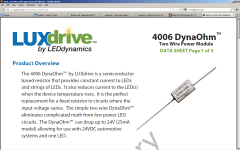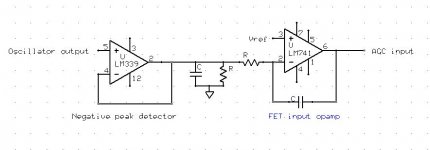Eagle seems like it ought to be the greatest thing ever... but my vote on it is also 
I'll take a look at DipTrace. -Thx RNM

I'll take a look at DipTrace. -Thx RNM
Last edited:
Why does it have to be thermal RMS why not log computing? I forgot to mention that that was what I made, I epoxied a power resistor to the 3300ppm Tellabs resistor and put it in a styrofoam isolation surround. When it finally locked in I got -130dB or so.
Well it doesn't have to be thermal RMS. We have to work with what's out there and RMS stuff is available. I haven't found a manufacture that's interested in catering to low distortion oscillators otherwise we might have perfect device. Maybe not. If it's not used by industry or by the military then no one is interested, understandably.
Cheers,
Thank's
As for RMS in this application neither the BW or dynamic range is an issue so something like an AD637 should work just fine. I found a huge stash in my junk bin (nice gold DIP's) if you want a couple.
Sure. What do you want for them?
Nothing, just PM an address and later tell us if it is useful.Sure. What do you want for them?
PCBs
This is the place I was referring to.
I see there setup charge has gone up.
Used to be $12.00.
This is a quote on 1 6x9" board double sided.
If the solder mask was left off it would be $24.00 cheaper.
I wonder then if it would be tinned?
For a development board it would be better to not have a mask.
Anyone heard of these guys?
This is the place I was referring to.
I see there setup charge has gone up.
Used to be $12.00.
This is a quote on 1 6x9" board double sided.
If the solder mask was left off it would be $24.00 cheaper.
I wonder then if it would be tinned?
For a development board it would be better to not have a mask.
Anyone heard of these guys?
Attachments
"Thermocouples won't work since they generate DC from the heat instead of a resistance change."
A change in current is all we need. Maybe a resistor in series. Driving a virtual ground node???
Actually I got he idea for this multiplier from an old HP wide band RMS detector which used a pair of thermocouples in a vacuum tube. The one thermocouple is heated by the other converting an AC loop to DC loop.
I'll look up the model number.
A change in current is all we need. Maybe a resistor in series. Driving a virtual ground node???
Actually I got he idea for this multiplier from an old HP wide band RMS detector which used a pair of thermocouples in a vacuum tube. The one thermocouple is heated by the other converting an AC loop to DC loop.
I'll look up the model number.
They look interesting but they are polarized and need .6V to turn on so they are most likely a semiconductor circuit. And no glow. .
The Ballast resistors date back to the early 20's.
The HP3400 and HP3403 use dual thermocouples to measure AC voltage. You need a chopper amp to measure the voltage off of the thermocouple. Seeing the price for a basic vacuum thermocouple I would leave them to the standards guys. I have an assortment but it took years to gather them. Except for NIST and a few obscure devices everyone has moved to digitizing for precision AC measurement so the market for these has really shrunk.
The Ballast resistors date back to the early 20's.
The HP3400 and HP3403 use dual thermocouples to measure AC voltage. You need a chopper amp to measure the voltage off of the thermocouple. Seeing the price for a basic vacuum thermocouple I would leave them to the standards guys. I have an assortment but it took years to gather them. Except for NIST and a few obscure devices everyone has moved to digitizing for precision AC measurement so the market for these has really shrunk.
They look interesting but they are polarized and need .6V to turn on so they are most likely a semiconductor circuit. And no glow. .
The Ballast resistors date back to the early 20's.
The HP3400 and HP3403 use dual thermocouples to measure AC voltage. You need a chopper amp to measure the voltage off of the thermocouple. Seeing the price for a basic vacuum thermocouple I would leave them to the standards guys. I have an assortment but it took years to gather them. Except for NIST and a few obscure devices everyone has moved to digitizing for precision AC measurement so the market for these has really shrunk.
I can't find any of these ballast. The company was bought out and only make relays now.
Amperite - Solving your relay requirements since 1922
They seem to be still at it. You may need to call them. The linear current range seem large so they could be well suited to this task.
They seem to be still at it. You may need to call them. The linear current range seem large so they could be well suited to this task.
AC level detector
Here is one could do the job:
http://www.thatcorp.com/datashts/THAT_2252_Datasheet.pdf 80 KHz max. Most of the current devices are focusing on 800 MHz to 2 GHz.
Attached is the simplest peak detector I could think up that would work. The LM339 is an open collector comparator. The input circuit is very like an opamp and what happens here is the the output follows the input until it goes positive. Since its open collector the output is then limited by the charge on the cap and the pull up resistor. Because its a moderately fast comparator the internal circuitry doesn't latch up or slow down when there is significant differential on the inputs. I have used this in several applications in the past and it worked well. And you have three more sections of the LM339 to do useful things with.
Here is one could do the job:
http://www.thatcorp.com/datashts/THAT_2252_Datasheet.pdf 80 KHz max. Most of the current devices are focusing on 800 MHz to 2 GHz.
Attached is the simplest peak detector I could think up that would work. The LM339 is an open collector comparator. The input circuit is very like an opamp and what happens here is the the output follows the input until it goes positive. Since its open collector the output is then limited by the charge on the cap and the pull up resistor. Because its a moderately fast comparator the internal circuitry doesn't latch up or slow down when there is significant differential on the inputs. I have used this in several applications in the past and it worked well. And you have three more sections of the LM339 to do useful things with.
Attachments
Here is one could do the job:
http://www.thatcorp.com/datashts/THAT_2252_Datasheet.pdf 80 KHz max. Most of the current devices are focusing on 800 MHz to 2 GHz.
Attached is the simplest peak detector I could think up that would work. The LM339 is an open collector comparator. The input circuit is very like an opamp and what happens here is the the output follows the input until it goes positive. Since its open collector the output is then limited by the charge on the cap and the pull up resistor. Because its a moderately fast comparator the internal circuitry doesn't latch up or slow down when there is significant differential on the inputs. I have used this in several applications in the past and it worked well. And you have three more sections of the LM339 to do useful things with.
"Here is one could do the job:
http://www.thatcorp.com/datashts/THAT_2252_Datasheet.pdf 80 KHz max."
If I used enough of this sort of thing in cascade I should be able to push the ripple frequency right out of band. But it would cost a small fortune.
This one is a possibility.
Thanks,
"Here is one could do the job:
http://www.thatcorp.com/datashts/THAT_2252_Datasheet.pdf 80 KHz max."
If I used enough of this sort of thing in cascade I should be able to push the ripple frequency right out of band. But it would cost a small fortune.
This one is a possibility.
Thanks,
That's an IC version of the old DBX rms detector. When I visited DBX in 1977 they showed me a "blessed" one that came out with 120dB range that was enshrined with a huge analog readout meter as their "lab standard".
That's an IC version of the old DBX rms detector. When I visited DBX in 1977 they showed me a "blessed" one that came out with 120dB range that was enshrined with a huge analog readout meter as their "lab standard".
Hi Scott,
I was thinking that the ripple out of a squaring rms detector, like the AD536 or the ones you sent me, is double the frequency of the input. They accept dc so if I put a number of them in series it should multiply the ripple moving it up the bandwidth. Less filtering would be needed or better smoothing for the same amount of filtering. We don't need accuracy just repeatability and it should cover the bandwidth of interest. But these IC's are expensive. Is there another device that will do the same at a lesser cost.
This is building on an idea Dick Moore gave me some time ago.
Edit;
Come to think of it these devices double the frequency of AC. The output of the rms detector is dc with a ripple component that is not ac so it won't work.
Last edited:
First think of the very Best Way.... for best results. Then pay the cost to do it Best Way. Dont throw away the best way because it cost more. Too much consideration to an IC cost, other parts cost. Thx-RNMarsh
First think of the very Best Way.... for best results. Then pay the cost to do it Best Way. Dont throw away the best way because it cost more. Too much consideration to an IC cost, other parts cost. Thx-RNMarsh
Good advise Rick.
Okay Infinite sample and hold it is then. ADC to MDAC. No ripple.
So what if I have to give it a long time constant. The output will be pure.
Thanks,
Ok then lets do it that way. The best way for best performance.
[BTW--Did you look at the AD8436 (90dB dynamic range). An input amp with approp scaling will extend it]
Thx-RNMarsh
[BTW--Did you look at the AD8436 (90dB dynamic range). An input amp with approp scaling will extend it]
Thx-RNMarsh
Last edited:
Ok then lets do it that way. The best way for best performance.
[BTW--Did you look at the AD8436 (90dB dynamic range). An input amp with approp scaling will extend it]
Thx-RNMarsh
Yes I have looked at that but the package turned me off. It's the same as all other rms detectors. We still have a ripple component at the 2nd H to deal with.
ISH has no ripple at all or droop. There is a some glitch from MDAC switches but the integrator
in the proportional controller takes this out.
ISH has no ripple at all or droop. There is a some glitch from MDAC switches but the integrator
in the proportional controller takes this out.
OK. Then that is the way to proceed. Thx-RNMarsh
ISH has no ripple at all or droop. There is a some glitch from MDAC switches but the integrator in the proportional controller takes this out.
If the controller has proportional action (and it needs this to be fast settling) there is by definition no (significant) low pass filtering. So glitches surely contribute some distortion.
Samuel
- Home
- Design & Build
- Equipment & Tools
- Low-distortion Audio-range Oscillator


